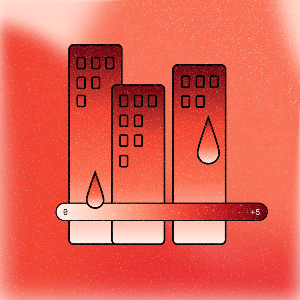Scorching asphalt: the climate crisis in cities
Heat islands, heatwaves, record temperatures: How climate change is heating up Europe’s cities – and where it is hitting hardest.

Heat islands, heatwaves, record temperatures: How climate change is heating up Europe’s cities – and where it is hitting hardest.

We are already feeling the heat. How much more the Earth heats up depends on what measures we take to combat climate change. As things stand, the planet has warmed by approximately 1.3°C on average compared to the preindustrial climate. “Based on current political measures – and depending on which of them are not just promised, but actually implemented – we’ll end up with somewhere between 2.2 and 3.4°C global warming by the end of the century from today’s perspective,” says Dr. Clemens Schwingshackl from LMU’s Department of Geography.
But the world is not heating up the same everywhere: Some areas are hit harder and others get off more lightly. In his research, Schwingshackl uses simulations of climate models for Europe in order to represent local effects of climate change with high spatial resolution. For example, he looks at how annual maximum temperatures change across the European continent assuming average warming of 3°C – an eminently possible scenario.
In 2024, the global average temperature was 15.1°C – a new record. In Europe, the average temperature was 10.69°C, making 2024 the warmest year since records began. The daily temperature measurements of weather stations – daytime and nighttime values – are used to calculate the annual average temperature.
“Annual maximum temperature records the highest level of heat that people are exposed to in a region in a year,” explains the climate researcher. Places where these extremes are shifting upward are exposed to higher stress – especially urban areas. As the majority of Europeans live in cities, the significance of this development needs no elaboration.
Southern Europe is warming more than the north. The aridification of land areas is a significant driver here. When water evaporates from the ground and vegetation, the vapor cools down the air. But the dryer a region becomes, the less water is available to cool it. “The effects of land aridification are highly apparent in our simulations. In Europe, Mediterranean countries will experience more warming than elsewhere as a result,” says Schwingshackl.
The Mediterranean Sea itself, however, does not heat up as much as the adjacent land regions. Coastal cities on the Mediterranean are therefore somewhat less affected, as they benefit from the relative coolness of the sea. Southern European cities in the interior will thus be hardest impacted by the additional heat in the future.
On the Baltic, the opposite is the case, with the sea warming faster than the surrounding land. “This could be because the sea is very flat and largely cut off from other seas,” conjectures Schwingshackl. Coastal cities like Copenhagen, Helsinki, and Stockholm are therefore more strongly affected by higher maximum temperatures than northern European cities that are further from the coast. And while the heat in northern European cities does not climb to the same heights as in southern Europe, northern Europeans are less used to the heat.
Clemens Schwingshackl
“It’s not unusual for temperatures to reach 35°C in Athens or Rome,” says Schwingshackl. “But if it’s 35°C in Oslo or Stockholm, people are not used to dealing with that heat for extended periods – and the infrastructure is not designed for it either.” To take this into account, Schwingshackl uses another indicator: the heatwave index, which describes heatwaves compared to the typical local climate.
And what about Germany? Although cities in the center of Europe are also in the middle when it comes to the effects of climate change, this does not mean they get away scot-free. Even today, the number of hot days (with maximum temperatures of over 30°C) is significantly higher than a few decades ago.
Schwingshackl cites the Bavarian capital to illustrate: “The trend is clear: Over the past 30 years, there has been a clear increase in the number of hot days in Munich.” Values that used to be recorded only in extremely hot summers have become the norm over the past five to ten years. “Ten days with temperatures above 30°C were an exception, something that happened only in very hot summers, but since the middle of the 2000s almost every year has been either close to or above this value.”
And then there have been a few extreme summers in the recent past: both 2003 and 2015 had more than 30 hot days – that is to say, over a month with temperatures above 30°C. “This is almost twice as much as the previous maximum before 2003. This never used to happen.”
As long as fossil emissions keep rising, the trend of recent years and decades looks set to continue, as Schwingshackl’s projections for the city of Munich clearly demonstrate. With progressing global warming, we expect there to be more and more hot days in Munich. The black line in Infographic 2 represents the average of various climate models for climate scenarios from 1.3°C (corresponding roughly to the status quo) to 4°C global warming.
Clemens Schwingshackl
However, there is a large range of uncertainty in the projections. “The number of hot days can turn out to be lower or considerably higher,” says the researcher. In the models for the 3°C scenario, Munich ends up on average with 30 hot days over 30°C – that is, the same amount every year as currently in extreme years. Some of the models predict “only” 20 hot days – others more than 50. “These are not the most likely scenarios, but they’re statistically possible for sure.”
There are reasons to suppose that the models tend to underestimate the heat increase. One such reason is trends in air pollution, which are not yet factored into the models. Aerosols in the air cool the local climate. In Europe, however, better filters and more e-mobility are likely to make the air cleaner in the future. While this is good for people’s health in general, it amplifies temperature increases in cities.
When the climate warms, cities suffer more than other areas. This is partly due to the so-called heat island effect. Soil sealing by roads and buildings means that less cooling takes place through water evaporation than in the surrounding country. Concrete and asphalt store heat, moreover, heating up powerfully during the day and then giving off this heat during the night. As a result, cities cool down at night much less than non-urban areas. In addition, high buildings obstruct wind, which can carry heat away from hot areas.
Another factor is the albedo effect. Brighter surfaces reflect more sunlight, while darker surfaces, such as roads covered with dark asphalt, absorb light and convert it into heat. And finally, cities themselves produce heat. The huge volumes of energy they consume – automobile traffic, electrical devices, air conditioning – are ultimately always converted into heat.
Munich too is a heat island. Anyone looking to cool down should go to places where there are plants and water: parks like the English Garden or pleasant spots along the banks of the river Isar. Areas where the ground surfaces are largely sealed are particularly prone to heating up. “This includes the old city, the area around the main train station, and the network of tracks leading from there out of the city,” explains Schwingshackl’s colleague Gereon Seeberg, who has created a heat map of surface temperatures in and around Munich during the summer.
Clemens Schwingshackl

Dr. Clemens Schwingshackl is a researcher at the Chair for Physical Geography and Land Use Systems. | © Astrid Arnslett/CICERO
Moving away from the center of town, the BMW complex in the north of Munich is an extreme hotspot. “This is because of the huge dark roof surfaces that BMW has in its industrial park,” says Seeberg. Industrial estates with such huge roof areas have also been shown to be particularly hot in other cities.
This insight helps researchers develop possible solutions: “Students in one of my seminars recently devised a greening concept for these BMW roof surfaces and the main train station as a way to cool them down by relatively simple means,” says Schwingshackl.
As a general rule, cities with many green areas are less affected by heat. When green areas are incorporated into built-up areas, the benefits for the population are even greater, as the cooling not only works its magic in the park, but also in apartment and office buildings. And thus smart, forward-looking urban planning can help mitigate heat in cities and prepare them for the future.
Read more articles from LMU's research magazine in the online section and never miss an issue by activating the magazine alert!